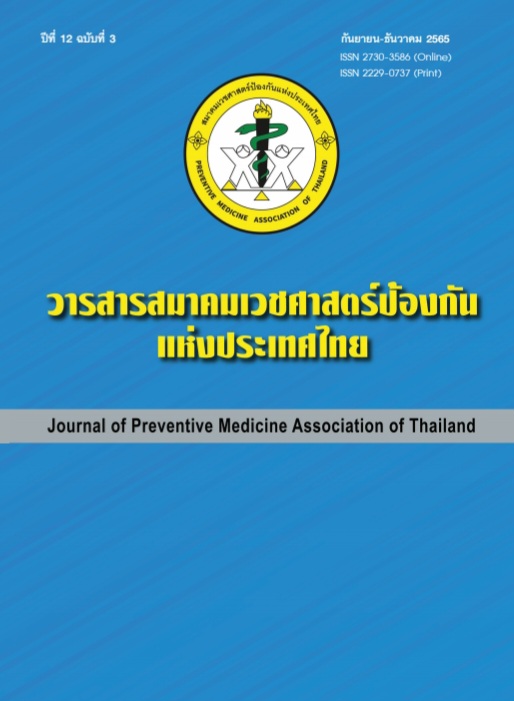Prevalence of Hypertension, Diabetes, Hyperlipidemia, Obesity, and Metabolic Syndrome Between Medical Corps Personnel and Other Corps
Keywords:
hypertension, diabetes, obesity, medical personnel, Royal Thai ArmyAbstract
Background: Nowadays, many countries around the world expect healthcare professionals to maintain a healthy lifestyle in order to be a role model for their communities. However, there is limited information regarding hypertension, diabetes, hyperlipidemia, obesity, and metabolic syndrome among medical corps personnel in the Royal Thai Army.
Objective: To determine the prevalence of hypertension, diabetes, hyperlipidemia, obesity, and metabolic syndrome between Medical corps personnel and Other corps
Methods: The annual health checkup information from Royal Thai Army database was obtained throughout the year in 2020. The extracted data was analyzed by using descriptive statistics.
Results: A total of 119,334 individual records were collected in 2020. Of 9,832 (8.2%) medical personnel, there were 5,528 (56.2%) females and 4,304 (43.8%) males. The highest prevalence of NCDs among healthcare workers was found in the top three as follows: Hyperlipidemia (89.2%), obesity (38.1%) and metabolic syndrome (21.5%), respectively. In contrast, the top three prevalence of NCDs among non-medical workers was hyperlipidemia (88.4%), obesity (44.3%) and hypertension (27.3%), respectively.
Conclusions: The study found that medical personnel in the Royal Thai Army had a relatively lower prevalence of hypertension, diabetes, obesity, and metabolic syndrome except for hyperlipidemia. It was expected that the aforementioned results are due to medical personnel in the Royal Thai Army have higher health literacy.
References
World Health Organization. Noncommunicable diseases [Internet]. 2022 [cited 2022 Oct 14]. Available from: https://www.who.int/news-room/fact-sheets/detail/noncommunicable-diseases
World Health Organization. 5-Year national NCDs prevention and control strategic and action plan (2017-2021) [Internet]. 2017 [cited 2022 Apr 4]. Available from: https://www.who.int/docs/default-source/thailand/ncds/national-ncd-prevention-and-control-plan-2017-2021-eng.pdf
Poulter N. Global risk of cardiovascular disease. Heart 2003;89(suppl 2):ii2-5.
Klunklin A, Sawasdisingha P, Viseskul N, Funashima N, Kameoka T, Nomoto Y, et al. Role model behaviors of nursing faculty members in Thailand. Nurs health sci 2011;13(1):84-7.
Bryant R, Benton DC. Delivering quality serving communities : nurses leading chronic care. Nursing Journal of India 2010;101(5):98.
Tejoyuwono AAT. Health lecturers and students views’ about healthcare workers’ as healthy lifestye role models: a qualitative study. IJNP (Indonesian Journal of Nursing Practices) 2020;4(1):28-36.
Aranda K, McGreevy D. Embodied empathy-in-action: overweight nurses’ experiences of their interactions with overweight patients. Nurs Inq 2014;21(1):30-8.
Kelly M, Wills J, Jester R, Speller V. Should nurses be role models for healthy lifestyles? results from a modified Delphi study. J Adv Nurs 2017;73(3):665-78.
Mekonnen TH, Tefera MA, Melsew YA. Sick at work: prevalence and determinants among healthcare workers, western Ethiopia: an institution based cross-sectional study. Ann Occup Environ Med 2018;30(1):1-10.
Gustafsson Sendén M, Løvseth L, Schenck-Gustafsson K, Fridner A. What makes physicians go to work while sick: a comparative study of sickness presenteeism in four European countries (HOUPE). Swiss Med Wkly 2013;143:w13840.
Sánchez-Zaballos M, Baldonedo-Mosteiro M, Mosteiro-Díaz MP. Presenteeism among emergency health care staff. Emergencias 2018;30(1):35-40.
Tan PC, Robinson G, Jayathissa S, Weatherall M. Coming to work sick: a survey of hospital doctors in New Zealand. N Z Med J 2014;127(1399):23-35.
Unger T, Borghi C, Charchar F, Khan NA, Poulter NR, Prabhakaran D, et al. 2020 International Society of Hypertension global hypertension practice guidelines. Hypertension 2020;75(6):1334-57.
Pan WH, Yeh WT. How to define obesity? Evidence-based multiple action points for public awareness, screening, and treatment: an extension of Asian-Pacific recommendations. Asia Pac J Clin Nutr 2008;17(3):370-4.
Expert Panel on Detection Evaluation, and Treatment of High Blood Cholesterol in Adults. Executive summary of the third report of the National Cholesterol Education Program (NCEP) Expert Panel on Detection Evaluation, and Treatment of High Blood Cholesterol in Adults (adult treatment panel III). Jama 2001;285(19):2486-97.
Saridi M, Filippopoulou T, Tzitzikos G, Sarafis P, Souliotis K, Karakatsani D. Correlating physical activity and quality of life of healthcare workers. BMC Res Notes 2019;12(1):208.
Downloads
Published
How to Cite
Issue
Section
License
Copyright (c) 2023 Journal of Preventive Medicine Association of Thailand

This work is licensed under a Creative Commons Attribution-NonCommercial-NoDerivatives 4.0 International License.
บทความที่ลงพิมพ์ในวารสารเวชศาสตร์ป้องกันแห่งประเทศไทย ถือเป็นผลงานวิชาการ งานวิจัย วิเคราะห์ วิจารณ์ เป็นความเห็นส่วนตัวของผู้นิพนธ์ กองบรรณาธิการไม่จำเป็นต้องเห็นด้วยเสมอไปและผู้นิพนธ์จะต้องรับผิดชอบต่อบทความของตนเอง






